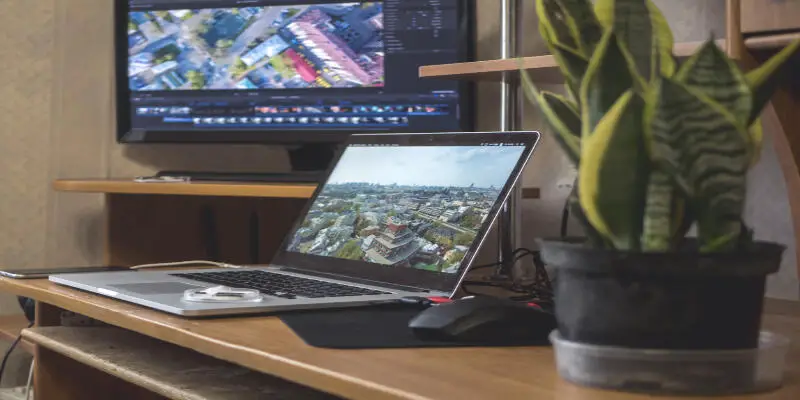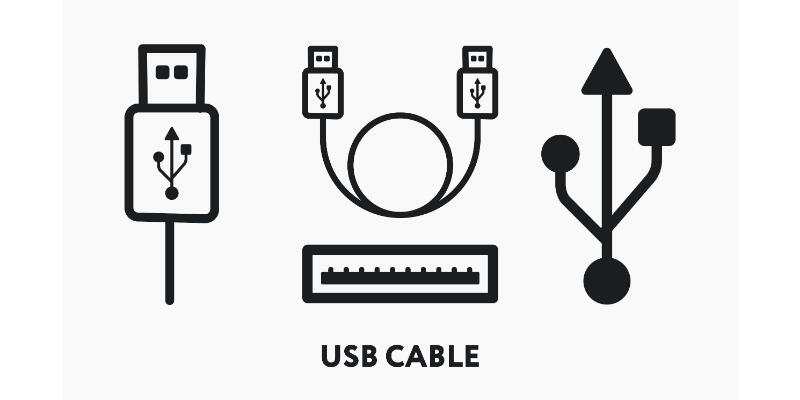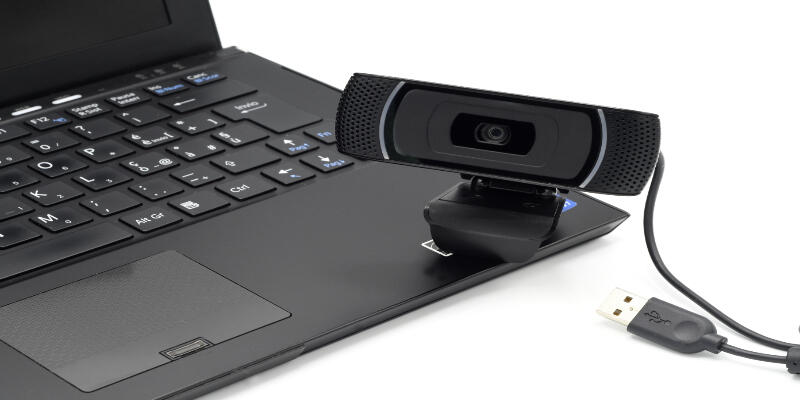Disclaimer: This post may contain affiliate links, meaning we get a small commission if you make a purchase through our links, at no cost to you. For more information, please visit our Disclaimer Page.
One type of port that has most people curious is the Universal Serial Bus (USB) port on a computer monitor. Often, someone will try to plug in cameras, printers, flash drives, gaming controllers, and other types of peripherals to transfer information between devices.
You can connect monitors via USB. Connecting a monitor via USB is one of the easiest ways to add a display monitor to your computer setup. Another way to use a USB-connected monitor is by making it function as an extender or USB hub for the PC.
Contrary to popular belief, the USB ports on the monitor are not used for playing media files such as video.
As extenders, the USB ports on the monitor are used to plug in PC accessories such as a keyboard, webcam, or mouse. To play media files directly, you will need a monitor with Smart TV capabilities.
Table of Contents
What Is The Purpose Of USB Port On Monitor?
If your computer monitor has USB connections, they are for extending your PC’s connectivity. The USB ports allow your monitor to act as a USB hub.
The male USB connector at the end of the cable is called a plug. The female connector is what you find on your device, such as PC or monitor, and is called a port or receptacle.
There are several types of USB ports on computer monitors. You’re likely to find a USB port UP type A. It’s square in shape and looks like a printer port.
The type A port connects your monitor to the PC, through one of the computer’s USB ports.
Besides the one type A USB port, you may also find one or more type B USB ports. These are rectangular in shape and commonly referred to as Standard-B connectors. Type B ports connect computer peripherals like keyboards and mouse through the mouse to the PC.
Modern computer monitors may have the USB 3.0 ports. The ports can accommodate USB 1.1 and USB 2.0 type B USB cables. However, USB 3.0 cables can’t go into USB 1.1 or USB 2.0 ports.
Unlike the previous two USB versions, USB 3.0 connectors are wider to accommodate extra pins. Instead of four pins of previous connectors, USB 3.0 standard B has nine pins. There’s also the USB powered-B which has 11 pins. The additional two pins provide power.
The simplest way to identify a USB 3.0 is the distinctive blue color. USB 3.0 ports are also stamped as “SS”, meaning Super Speed.
The surest way to identify a USB 3.0 port is the number of pins. 9 or 11 contact pins means that’s a USB 3.0 while 4 contact pads means it could either be a USB 1.1 or a USB 2.0. The USB Type-C has 24 pins.
The USB 3.0 ports and cables are faster than previous versions as they can transmit data at 5Gbps to 20Gbps while previous versions typically transmit at lower than 500Mbps.
If your monitor has Smart TV capabilities, then you may also have a 3rd type of USB port. This port is marked as 5V and 1A. It’s the ideal connection for external hard drives.
Unlike regular computer monitors, Smart TV monitors can play media files such as videos, audio files, slides, and photos.
Each monitor model has limitations on the type of media they can play. Limitations may be because of codecs, file formats, and the size of the memory device.
If you own a handheld video monitor, then it probably has a Micro USB port. There are micro-A, micro-B, and micro-C types.
They all come in different shapes and perform at different speeds. Of the three, Type-C is currently the most efficient and most devices are heading that way.
Micro USB connectors are only compatible with USB 3.0 devices. They don’t work with USB 1.1 or USB 2.0 devices. They offer transfer rates of approximately 480 Mbps.
Micro USB is suitable for connecting handheld monitors to digital cameras, tablets, cell phones, and GPS units. Apart from transmitting data, Micro-USB cables also function as power and charging cables.
Why Would I Choose a USB Connection over Other Connection Types?
In most cases, it’s easier and less expensive to connect your monitor using the more traditional VGA, DVI, or HDMI connection. However, USB offers a plug and play simplicity while also offering low latency and superior video playback.
Expandability
Another reason for preferring USB over other connection methods is the expandability. You can connect six more screens to your computer setup using USB cables.
You will not need to add any other hardware such as graphic cards. If you’re using Windows Multipoint Server, you can connect up to 14 more screens. With Mac, you can add four more screens.
That means for example, if you’re showing a video presentation at a conference, you can hook up many display monitors with USB cables without needing extra graphics cards.
That setup results in lower installation costs, lower maintenance costs, and a less complex infrastructure.
Another example of where you would want to use multiple display monitors is at a Point of Sale for customer checkouts. One screen would face the cashier while the other screen faces the paying customer.
Simplicity and Portability
USB connections for computer monitors provide simplicity and portability. If you were to add a monitor using traditional connections, you would require a video cable. That would be either a VGA, HDMI, or DVI cable.
You would also need a power cable and probably a USB connection for touch data. The power cable would need to connect to a power brick or electric outlet.
However, a USB monitor requires only that one cable which transports touch data, powers the monitor and peripherals, and transmits video at high resolution.
Less Space
USB connections use up less space than other types of connections. The cables are thinner and the connectors are smaller than DVI, VGA, and HDMI. Plus, all you need is a single cable and it will transmit all data while also charging the monitor.
Power Efficiency
USB connections use less electricity than traditional connections. This is because USB connections compress and transmit data through software functions rather than hardware.
A dedicated hardware doing the same job would be using up power, even when idle. USB connections avoid power wastage and use up to 80% less electricity.
How Do I Use USB Ports On My Monitor?
Few people know this, but you can plug your monitor to the PC through the USB port rather than the VGA connector.
You will need a monitor with a Type A-UP USB port. You’ll also need an A-Male to B-Male USB cord. The B-Male end goes into the PC’s Type B port while the A-Male end goes into the monitor’s Type A port.
For the best signal clarity, get a cable with corrosion-resistant gold-plated connectors. Find cables that offer shielding to minimize electromagnetic interference.
Certain monitors come with USB ports, but the ports don’t work unless you activate them first. To activate a USB port, you must connect your monitor to your PC.
Monitors that come with USB ports usually also come with a USB upstream cable as part of the package. The upstream cable has one end Type-A male USB and the other end Type-B male USB.
To activate the monitor’s USB ports, follow these steps:
- Turn off your PC.
- Locate the square-shaped Type-A port on your monitor.
- Connect the type-B end of the cable to the type-B port on your monitor.
- Connect the type-A end of the cable to one vacant type-A port on your PC.
- Switch on your computer.
- Go to settings and add a USB device. The computer should detect your monitor.
- If the computer doesn’t detect the monitor, check if the computer’s packaging includes a disc containing the monitor’s drivers. Run the disk and add the monitor as a USB device.
- If you can’t find the disc containing drivers, you can download drivers from the monitor manufacturer’s website.
What Connections Do Monitors Use?
To expand your visual workspace, computer monitors have several types of connections. The increase in the number of available ports is driven by demand for higher-resolution displays.
The types of interfaces have also increased. For example, the kind of monitor environment a gamer would want might be different from what a stock trader would need.
Yet both will want to add extra monitors to their display environment.
Thus, users face the question of what input systems they should connect to which terminals. Monitors typically have both analog and digital terminals. Depending on the type of interface, these are the terminals you’re likely to encounter:
VGA
The Video Graphics Array is the oldest connection type on most monitors today. In the current market, most of the major laptop makers don’t create laptops with VGA ports.
It’s very likely that soon the VGA will be obsolete, even on PCs.
VGA ports have 15 contact pins in three rows of five. The connection works by transmitting Red, Green, Blue, Horizontal Sync, and Vertical Sync (RGBHV) video signals.
The VGA only transmits analog signals, which means its output is of lower quality compared to HDMI and USB.
DisplayPort
DisplayPort is popular because of its codec that produces clear graphics with very low latency. DiplayPort is a link-aware connection that works with a wide range of data transmitters such as USB 2.0, USB 3.0, and Wi-Fi.
DisplayPort works with both 802.11ac and 802.11ad in wireless docking mode.
You can use DisplayPort with a Universal Docking Station to support multiple monitor displays. On the Universal Docking Station, you may also add audio, Ethernet, and more USB peripherals.
You may use the station with MacBook, Chromebook, Ultrabook, laptops, tablets, and Android devices.
HDMI
The High Definition Multimedia Interface (HDMI) is a popular connection that supports both audio and visual transmissions. HDMI connections are effective at connecting HD outputs to a HD display without loss of resolution in images and videos.
You can easily add a monitor to your PC setup using a single HDMI cable. The cables are inexpensive, widely available, and user friendly.
One advantage the USB has over HDMI is distance. HDMI can only transmit data over relatively short lengths. The upper limit is 15 meters or 50 feet. The standard size HDMI is also bulky compared to the standard size USB.
DVI
The Digital Visual Interface (DVI) was formerly the standard connection for video playing devices. Since it transmits data at resolutions of up to 2560 x 1600, DVI works well with modern graphic cards and flat screen LCD monitor displays.
The DVI is a favorite option for HDTVs and video players such as DVDs, Movies, and high end televisions. DVI connections also support projectors and computer monitors.,
Ethernet
If your computer doesn’t have a USB or HDMI connection, you can still use an Ethernet connection to play HD videos.
An added advantage of using an Ethernet connection is your monitor can now be part of a shared network. All other devices on the network can use the monitor as a display when needed.
To connect your monitor via Ethernet, you may need an IP extender. The extender allows the networked devices to connect directly with the monitor.
USB
You can connect your display monitor with a Type-A male to Type-B male USB 1.1 or USB 2.0 connection. However, the market is moving towards the more universal USB-C.
USB-C is the ultimate connector and is widely considered the current industry standard. The USB-C has 24 pins and transmits both data and electric power.
USB-C cables are compact and has reversible orientation. This means you can connect it in any direction and your devices don’t need multiple types of connectors.
The USB-C is twice as fast as USB 3.0. It delivers up to 100W, compared to the 2.5W capacity of USB 2.0. Thus, it can power large devices such as laptops and small devices such as smartphones.
Can You Connect A Monitor Via USB-C?
Most of the newer monitors have one or more USB-C ports. For instance, all new MacBooks use USB-C. Thunderbolt 3 ports are also USB-C ports, except the thunderbolt is much faster. There are several ways you can connect a monitor via USB-C.
With most new connectors having the USB-C universal solution, connecting a monitor is as simple as connecting a Type-C cable between the monitor and the other device.
The best advantage of connecting a monitor via USB-C is that USB-C connectors allow for the transmission of high resolution videos and images.
The USB-C can transmit at least 2160 x 1440 and 3840 x 2160 (4K UHD). The USB-C can transmit with a refresh rate of 60 frames per second (60Hz)
With older devices that come without a USB-C port, you might need a converter to connect your monitor.
To connect a monitor to a laptop or PC, simply use the USB-C cord to connect the two. The laptop or PC displays its image signals on the monitor screen.
The cord will also transfer electric power between the two devices, acting as a charger for your laptop. In this way, your monitor acts as a docking station. This saves you the headache of dealing with multiple cables to charge your laptop.
The USB-C port on your laptop can charge different devices in the same way. Some devices you can charge with your monitor via the USB-C cable include smartphones, tablets, digital cameras, and GPS units.
To connect your monitor to a laptop as a docking station, ensure that your monitor supplies the correct wattage.
Keep in mind that not all USB-C cables can transmit image signals. When connecting a USB-C cable to your monitor, ensure it’s a cable type that can transmit image signals.
Can I Connect A VGA Monitor To A USB Port?
You can use adapters to change a computer USB port into an external video output. This allows you to connect the computer to a VGA monitor.
Many of today’s laptops come without a VGA port. So if you want to connect it to an older monitor, you will have to connect via a USB to VGA adapter. There are also cables with in-built adapters.
Most of the common adapters support up to 1080p resolution and work with USB 1.1, USB 2.0, and USB 3.0 ports. Once you have the adapter:
- Install the adapter’s drivers to your computer.
- You can download drivers from the manufacturer’s website.
- Install the drivers.
- Switch off your computer.
- Connect the VGA cable to the monitor and the other end goes into the adapter.
- Connect the USB cable to the adapter and the other end goes to your PC.
- Start your computer.
- The computer should detect the adapter and install, instantly connecting to the monitor.
Can You Use USB to HDMI for Monitor?
The USB and HDMI ports look confusingly alike. However, they are not the same. Nonetheless, you can connect USB to HDMI for your monitor.
To use your monitor on a USB to HDMI connection, you will need a USB-HDMI adapter. Most adapters will only be compatible with USB 3.0.
The adapter uses the USB port on your PC to connect to the HDMI port on your monitor, HDTV, or projector.
The USB-HDMI adapter acts as an extension to add more ports to your PC connections. The adapter also works like an external graphics card as it delivers seamless high definition video to your monitor.
Most USB-HDMI adapters in the market today support video resolutions of up to 1080p and 2160p.
What Peripherals Can You Connect To The Monitor Via USB?
A basic computer setup typically has a CPU case, monitor, mouse, and keyboard. When you want to add more devices to the setup, you might need a more complex setup. If the USB ports on your computer are full, your monitor can be a USB hub.
Some of the peripheral devices you can connect to a computer setup via the USB ports of a monitor include:
Printers
You can connect a printer to print documents and images that appear on your display screen.
Speakers
You can connect audio speakers and headphones to the USB ports of your monitor. Some monitors also have audio jacks or in-built speakers.
Gaming Controllers And Joysticks
Gamers can add some types of consoles and controllers to the USB port of the monitor. Some gamers report a lag when controllers are connected to the monitor rather than directly to the PC.
This usually happens if the monitor lacks the capacity to power the extra devices.
Webcams
You can connect to a camera to take pictures and record videos. The webcam can also transmit internet videos in real time, making it possible to video chat and video conference.
Mobile Devices
You can use the USB ports on your monitor to connect smartphones, digital cameras, tablets, MP3 players, and other handheld devices.
Microphones
You can connect a USB microphone to your monitor. The microphone allows you to record sound and talk to others in real time over the internet.
Conclusion
Sometimes a single-screen display isn’t enough. When one display is too limiting, adding an extra monitor can allow you to open more programs and help you multitask better.
Connecting a monitor via USB can lead to better resolution, faster speeds, and a neat computer connection that saves on space. The best connection would be USB-C, though USB 1.1 and USB 2.0 work well too.



